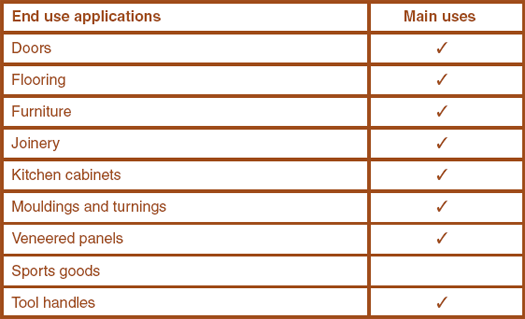Red Oak




Botanical name: Quercus spp.
Common/commercial names: Northern red oak, Southern red oak
Distribution & Availability
Widespread throughout Eastern USA. The oaks are by far the largest species group growing in the Eastern hardwood forests. Red oaks grow more abundantly than the white oaks. The red oak group comprises many species, of which about eight are commercial. Excellent availability as lumber or veneer in a wide range of grades and specifications. Red oak is often classified according to growing regions and marketed as Northern red oak and Southern red oak.
General Description
The sapwood of red oak is white to light brown and the heartwood is often a pinkish reddish brown. The wood is similar in general appearance to white oak, but with a slightly less pronounced figure due to the smaller rays and a more porous end grain structure. The wood is mostly straight grained with a coarse texture.
Physical & Mechanical Properties

The wood is hard and heavy, with medium bending strength and stiffness and high crushing strength. It is very good for steam bending. More detailed strength information is available in AHEC's publication Structural design in American hardwoods.
Working Properties

Red oak machines well; nailing and screwing is good although pre-boring is recommended, and it can be stained and polished to a very good finish. It performs best when dried slowly, reducing the opportunity for degrade such as splits and warp. It has a high shrinkage and can be susceptible to movement in performance under variable moisture conditions.
Durability
Rated slightly non-resistant to heartwood decay, moderately easy to treat with preservatives.
Main Uses

Construction, furniture, flooring, architectural interiors, internal joinery, stairs and mouldings, doors, kitchen cabinets, panelling and coffins. Not suitable for tight cooperage. Red oak can vary in colour, texture, characteristics and properties according to the growing region. It is therefore recommended that users and specifiers work closely with their suppliers to make sure the wood they order is suited to their specific needs.
Other Information
This attractive looking oak, that is widely available, is increasingly being chosen by designers and architects for furniture, joinery and flooring in export markets around the world. While some red oak can have a distinct pink or red colour, other supplies can appear very similar to white oak. This is especially true once a finish is applied, which results in more ‘mixed oak’ products. The large volume of red oak production ensures that lumber availability is good and that a high proportion of long, wide boards with uniform grain can be obtained. For the same reason, red oak is increasingly available sorted to width and length for specific applications.
